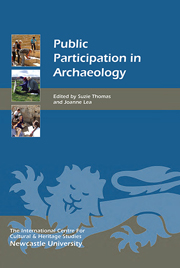Book contents
- Frontmatter
- Dedication
- Contents
- List of Illustrations
- Acknowledgments
- List of Abbreviations
- Preface
- Introduction
- Public Participation in Archaeology: International Models
- 1 From ‘Telling’ to ‘Consulting’: A Perspective on Museums and Modes of Public Engagement
- 2 Making Archaeological Heritage Accessible in Great Britain: Enter Community Archaeology
- 3 Public and Community Archaeology — an Irish Perspective
- 4 The Scope and Potential for Community Archaeology in the Netherlands
- 5 Public Archaeology as a Reflexive Practice: An Argentine Case Study in the Pampean Region
- Public Participation in Archaeology Through Education
- Public Participation in Archaeology Through Tourism
- Public Participation in Archaeology Through Site Management and conservation
- List of Contributors
- Index
5 - Public Archaeology as a Reflexive Practice: An Argentine Case Study in the Pampean Region
from Public Participation in Archaeology: International Models
Published online by Cambridge University Press: 05 August 2014
- Frontmatter
- Dedication
- Contents
- List of Illustrations
- Acknowledgments
- List of Abbreviations
- Preface
- Introduction
- Public Participation in Archaeology: International Models
- 1 From ‘Telling’ to ‘Consulting’: A Perspective on Museums and Modes of Public Engagement
- 2 Making Archaeological Heritage Accessible in Great Britain: Enter Community Archaeology
- 3 Public and Community Archaeology — an Irish Perspective
- 4 The Scope and Potential for Community Archaeology in the Netherlands
- 5 Public Archaeology as a Reflexive Practice: An Argentine Case Study in the Pampean Region
- Public Participation in Archaeology Through Education
- Public Participation in Archaeology Through Tourism
- Public Participation in Archaeology Through Site Management and conservation
- List of Contributors
- Index
Summary
Introduction
In this chapter we summarise the development of public archaeology in Argentina, discussing some of the difficulties encountered and introducing, by way of an example, the work of the Grupo de Arqueología en las Pampas (GAP). The GAP is comprised of 17 people, including professional archaeologists and students. Their goal is to share the results of archaeological research carried out in three towns of the Buenos Aires province in Argentina: Bahía Blanca, Necochea and Chascomús (see Fig 5.1). Based on their population sizes, these are classed as small and mid-scale towns.
The communities of the three towns are culturally diverse as they are comprised of people with very different historical roots, although the most prevalent population group has its roots in the overseas migration of the late 19th century and mid-20th century. Therefore, anything related to native tradition is omitted from the hegemonic political process. Due to the resulting inequality, the cultural practices of the European and occidental migrants emerged as the privileged systems and indigenous history pre-dating the 19th century became invisible. As a result, the migrants' cultural practices came to form the heritage background of the communities.
The above-mentioned archaeological research focuses on native, pre-colonial history and is carried out by three different research teams. Each of these teams studies different geographic areas of the Buenos Aires province and specific subjects within those areas. However, members of the GAP share the same aim: for the results of their research to reach beyond academic boundaries.
- Type
- Chapter
- Information
- Public Participation in Archaeology , pp. 61 - 70Publisher: Boydell & BrewerPrint publication year: 2014



